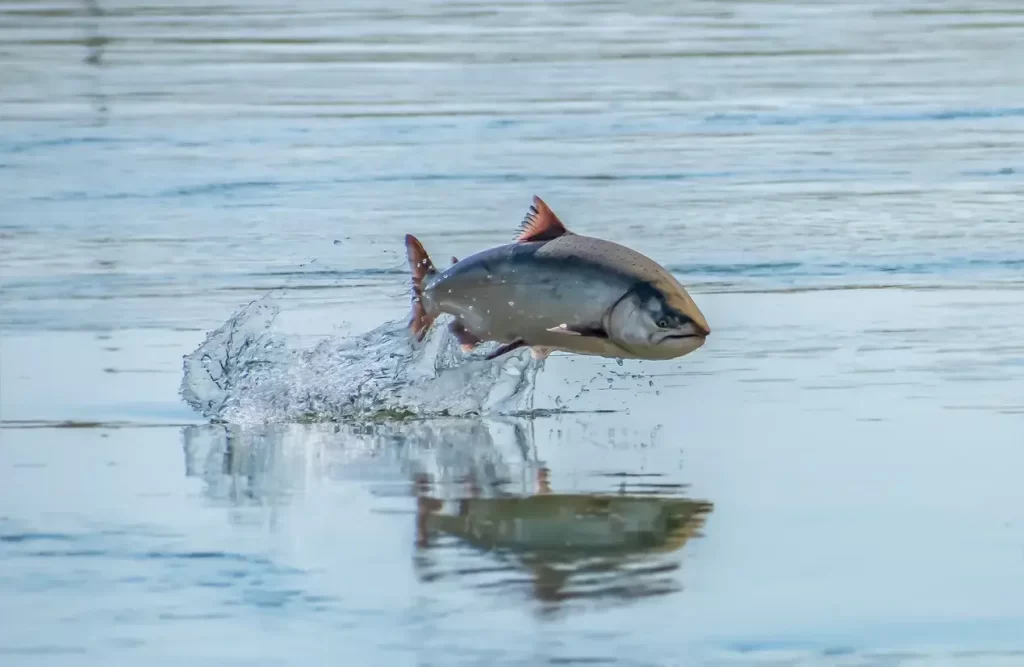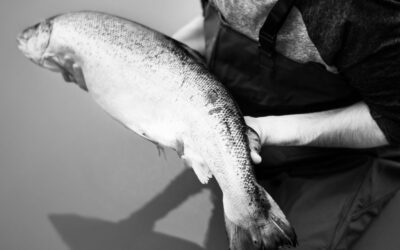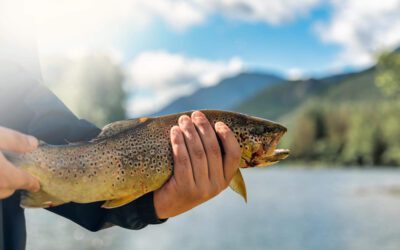For many angling enthusiasts like myself, the pursuit of salmon is an exhilarating journey. Bead fishing has emerged as a highly effective method to target these magnificent fighters, simulating the eggs that salmon and other species key in on, especially during spawning seasons. The art and science of bead fishing for salmon combine knowledge, strategy, and a bit of luck, making each outing a unique and rewarding experience.
In this comprehensive guide, I’ll dive into the details of bead fishing for salmon, sharing insights and tips garnered from numerous hours spent by the water. From strategies, to hook size, to bead color and more, this salmon fishing guide will teach you everything you need to know.
Key Points
- Strategies for Bead Fishing for Salmon are essential for success, involving choosing the right bead size, color, and presentation.
- Hook Size is crucial and must be matched with the bead size and the size of the targeted salmon.
- Bead Colors play a significant role, and having a variety of colors can be advantageous to adapt to the salmon’s preference.
- Rig Setup for bead fishing needs meticulous attention to detail for a natural presentation.
- Best Gear ensures comfortable and effective bead fishing experience, including a suitable rod, reel, line, and accessories.
- Ideal Weather Conditions can optimize your chances, with overcast skies and stable temperatures being generally favorable for salmon fishing.

Strategies for Bead Fishing for Salmon
When bead fishing for salmon, adopting the right strategies is pivotal. Understanding the behavior of salmon, particularly their inclination towards certain colors and sizes of fishing beads during specific conditions, can elevate your fishing experience. Observing water clarity, adjusting the depth, and experimenting with different drift speeds can help in presenting the bead more naturally, enticing those wary salmon to bite.
Hook and Bead Size
The harmony between hook and bead size is crucial in bead fishing for salmon. A bead of around 8mm to 12mm is generally effective, matched with a hook size ranging from 4 to 8. The bead should not overshadow the hook, and the hook should be inconspicuous enough to not deter the salmon, yet strong enough to secure them.
Best Bead Colors for Salmon
When bead fishing for salmon, the color of the bead is often a pivotal factor influencing your success. In my many forays into the realms of river and stream, I have marveled at how the nuanced choices in bead color can spell the difference between a quiet day and a thrilling one.
- Natural Egg Colors: Observing the natural colors of the eggs present in the water is crucial. Salmon are often on the lookout for familiar and natural-looking food sources, especially during spawning seasons. Matching the prevalent egg colors can significantly enhance the attractiveness of your presentation.
- Variety of Hues: Having a variety of hues is essential as salmon preferences can change based on multiple factors like water clarity, lighting, and availability of natural food sources. My tackle box is typically stocked with beads in shades of orange, pink, red, and clear.
- Water Clarity and Light Conditions: Adapting bead color to the existing water color and light conditions can make your presentation more appealing to discerning salmon. In clear water under bright light conditions, subtle and transparent beads often yield better results, while in stained or murky waters, brighter and more vivid colors can be more effective.
- Experimentation and Observation: I often find myself experimenting with different colors, attentively observing the salmon’s reaction to each. Sometimes, a slight change in shade can trigger bites when nothing else seems to work.
Should I Use Glass Beads or Plastic Beads for Salmon?
The debate between glass beads vs plastic beads for salmon fishing is quite common among anglers, and the preference can largely depend on individual experiences, specific fishing conditions, and target fish behavior. I would recommend trying both during your trip. Also be sure to check out our full guide on glass fishing beads vs plastic fishing beads.
Rig Setup for Bead Fishing for Salmon
Setting up your rig properly is paramount for a successful bead fishing outing for salmon. An incorrect setup can make the bead look unnatural in the water and turn salmon off.
1. Positioning the Bead
The bead should be positioned approximately 2 inches above the hook to make it appear as a freely drifting egg. This distance can be adjusted based on observations and preferences. The bead is secured in place using a peg, toothpick, or a soft bead stopper to prevent it from sliding down towards the hook.
2. Choosing the Right Hook
Pairing the bead with the appropriate hook is crucial. A hook too large may spook the fish, while one too small might not secure the fish properly. A short-shank, up-turned eye hook ranging from size 4 to 8 generally works well with beads ranging from 8mm to 12mm.
3. Main Line and Leader Material
I typically opt for a high-visibility braided line for the main line, allowing for better line management and bite detection, coupled with a fluorocarbon leader for its low visibility and abrasion resistance.
4. Leader Length
The leader length can play a significant role in presenting the bead naturally. A longer leader might be necessary in clear water conditions where salmon are more wary, while a shorter one can be sufficient in colored water. I usually start with a leader around 18-24 inches and adjust as needed based on the conditions and the fish’s behavior.
5. Float or Bobber Setup
Using a bobber or a float is essential for maintaining the bead at the right depth and for detecting bites. The float should be adjusted to present the bead just above the bottom where salmon are likely to be holding.
6. Weight Placement
I place split shot or other weights between the bead and the float to achieve the desired depth and to ensure a natural drift. The amount and placement of weight might need adjustments depending on the current speed and depth.
7. Fine-Tuning the Presentation
Observing the drift and adjusting the rig components as needed is crucial for a natural presentation. The bead should drift along with the current, simulating a free-floating egg, enticing the salmon to bite.
8. Regular Checks and Adjustments
Regularly checking the rig for any signs of wear or damage and making necessary adjustments to the bead position, leader length, and float depth can optimize your chances of a successful outing.

Best Gear for Bead Fishing for Salmon
When embarking on my quests for salmon with my trusty beads, the gear I select becomes my ally in deciphering the watery enigma where salmon reside. Each piece is an extension of my senses, granting me the ability to communicate with the currents, feel the whispers of the underwater world, and connect with the noble salmon.
1. Rod Selection
A medium to medium-heavy rod is my rod of choice. Ideally, it should have a sensitive tip to detect subtle bites and sufficient backbone to handle the powerful runs and jumps of the salmon. A rod length of around 9 to 10.5 feet is generally preferable as it aids in better line control, casting distance, and mending.
2. Reel Selection
Choosing a reel with a smooth drag system is vital to managing the energetic bursts and sudden direction changes typical of a hooked salmon. I often opt for a high-quality spinning or baitcasting reel, well-balanced with the rod, and spooled with an adequate line.
3. Line Selection
The main line should be strong and responsive. I typically prefer a braided line with high visibility for the main line, allowing me to detect line movement and manage line more effectively. For leader material, a clear fluorocarbon line is my go-to due to its low visibility and resistance to abrasion.
4. Bead Selection
A selection of beads in varying sizes, colors, and textures is a crucial component of my gear. Having a range of options enables me to adapt to the salmon’s preferences and the prevailing water conditions, making my offerings more enticing.
5. Accessories
- Hooks: I equip myself with a variety of hooks to match different bead sizes. Short shank, up-turned eye hooks are generally effective, with sizes ranging between 4 to 8, depending on the bead size and the targeted salmon species.
- Floats/Bobbers: A reliable float or bobber is crucial for maintaining the proper depth and detecting bites. I tend to use floats that are easily adjustable and highly visible, allowing for quick adaptations to the changing water depths and lighting conditions.
- Weights: An assortment of split shot or other weights is necessary to achieve the desired bead depth and to ensure a natural drift. The choice of weight depends on the current speed, depth, and the desired presentation of the bead.
- Miscellaneous Gear: Bringing along essential accessories like pliers, scissors, hook sharpeners, and extra line ensures that I am well-prepared for any adjustments or unforeseen situations that may arise during my fishing escapades.
6. Protective Gear and Clothing
Appropriate clothing and protective gear such as waders, boots with good grip, a hat, sunglasses, and a waterproof jacket is essential to staying comfortable and safe during my time by the water.
Ideal Weather Conditions for Salmon Fishing
Understanding and leveraging the ideal weather conditions can significantly improve your success when bead fishing for salmon. Adapting your approach to weather changes can make the difference between a great day on the water and a slow one.
1. Overcast Skies
Salmon seem to prefer days when there’s a few more clouds. Overcast conditions often provide more consistent lighting and reduce glare, making salmon less wary and more likely to venture into shallow areas.
2. Light Rain
The rain can break the surface tension of the water, reducing the visibility of the line and the shadows and making salmon more comfortable in shallow waters.
3. Stable Weather
Periods of consistent pressure, temperature, and light conditions often result in more predictable salmon behavior and movement patterns.
4. Early Morning and Late Evening
Salmon are often more active during these periods, the low light levels making them feel more secure and willing to feed.
5. Temperature Considerations
Salmon are sensitive to water temperature changes. Ideal water temperatures usually range from 55°F to 64°F. Observing how the temperature variations affect the river can help adapt your approach and select the locations where salmon are more likely to be found.
FAQs about Bead Fishing for Salmon
Can I use the same bead color and size for all salmon species?
While some colors and sizes can be effective for multiple species, it’s best to have a variety of bead colors and sizes to adapt to the specific preferences of different salmon species and conditions.
Is bead fishing for salmon effective in clear water?
Bead fishing can be effective in clear water, but it’s crucial to use a more natural and subtle bead color and ensure that your line and rig are as inconspicuous as possible to avoid spooking the salmon.
How do I know the right depth to set my bead?
Observing the water and the position of the salmon, experimenting with different depths, and adjusting your float or bobber accordingly can help in presenting your bead in the salmon’s strike zone.
Is bead fishing legal everywhere for salmon?
Regulations can vary, so it’s essential to check local fishing regulations to ensure that bead fishing is allowed and to understand any specific rules or restrictions related to bead fishing for salmon.
Wrapping Up – Learn How to Bead Fish for Salmon
Bead fishing for salmon is both a precision-driven science and a creative art, requiring thorough strategy, proper gear alignment, and careful attention to detail. Each aspect, from choosing the right bead color and size, to setting up the rig and selecting the right equipment, is vital for success. Continually adapting and refining my approaches to meet the salmon’s varying behaviors and conditions is a central part of bead fishing. So, arm yourself with knowledge, get your gear ready, and step into the waters to feel the thrill of bead fishing for salmon! Tight lines!



